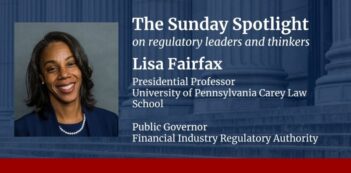
In the wake of bizarre market behavior, regulators move to expand disclosure on Treasury trades.
One Monday morning in October 2014, the United States Treasury securities and futures markets started behaving very, very strangely. In a six-minute stretch, the interest payment on 10-year Treasury notes plummeted 16 basis points—hundredths of a percent—and then, just as quickly, rebounded to the original yield level. Even more strangely, there was no obvious trigger for this chaotic market movement.
This event, quickly branded the “flash rally,” thoroughly spooked the financial world. The New York Times called it “unnerving” and “bizarre,” comparing the swing to the drop in bond yields that occurred when Lehman Brothers collapsed in 2008. Bankers quickly began pointing fingers: some blamed regulators for limiting the inventories of bonds that banks could hold, which causes more volatility in the market; others accused trading algorithms.
In order to help prevent such dramatic, unexpected Treasury market movement in the future, the Financial Industry Regulatory Authority (FINRA)—a government-sponsored private regulatory authority, responsible for regulating brokerages and stock exchanges and maintaining market fairness—recently adopted a proposed rule that will mandate new reporting requirements for transactions in Treasury securities. The new reporting requirements mandate that each party to a transaction involving most kinds of Treasury securities must report the transaction. Market participants could then access and view some, but not all, reported information.
The rationale behind the new rule is simple: the stability of the Treasury market is essential to the global economy. Antonio Weiss, the former Lazard investment banker turned Counselor to the U.S. Secretary of the Treasury, called the Treasury market the “deepest, most liquid securities market in the world” and heralded it as “unique and critical…in the global economy.” The Treasury market provides a risk-free benchmark for the rest of the global economy, allows the Federal Reserve to implement monetary policy, and serves as a primary financing source for the United States government.
To proponents of the new reporting requirement, increased transparency will allow traders to better understand market structure and will encourage new entrants into the market, increasing liquidity—the measure of how easy it is to buy or sell an asset. Maintaining high market liquidity serves to ensure that sellers receive full value for their assets. Nasdaq, in a comment in favor of the new rule, argued that market transparency allowed investors to react quickly and with accurate information. Another commenter lamented that the Treasury market lags well behind other securities markets in transparency, calling it “the largest dark pool in the U.S.”
In opposition to the rule, Credit Suisse argued that more comprehensive reporting requirements would actually make the market less liquid. Effectively, instantaneous reporting will sometimes have the side effect of letting the market know that there is only one buyer or one seller for a given security, allowing other market participants to offer a price that is too low to that buyer or seller.
Fretting about bond market liquidity has in recent years become a common occurrence among market participants. Liquidity worries have become so common that Bloomberg columnist Matt Levine has started to include a daily subsection titled “People are worried about bond market liquidity” in his newsletter.
Despite the controversy, the U.S. Department of the Treasury stated that there was “little compelling evidence” of a decline in liquidity, a position backed up by the Federal Reserve. Even so, a managing director at New Oak Capital, a financial consulting firm, noted that what regulators were saying about liquidity directly conflicted with what market participants believed.
The flash rally, and the market uncertainty it represented, prompted the primary regulators of the Treasury market—the Board of Governors of the Federal Reserve System, the Federal Reserve Bank of New York, the Securities and Exchange Commission (SEC), the Department of the Treasury, and the Commodities Futures Trading Commission— to release a joint report on this bizarre Treasury market behavior. The report concluded with four “next steps,” including an assessment of the data regarding the Treasury market available to regulators and the public. The Treasury Department then published a Request for Information seeking comment on the current structure of the U.S. Treasury market. After the receipt of public comments, FINRA adopted the new reporting requirements.
The new rule will go into effect July 10, 2017.



